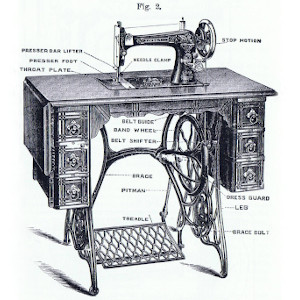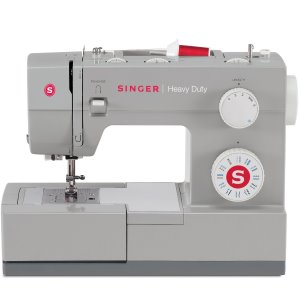 Over the years, with innovations in the field of technology, production of around 4000 different types of sewing machines has taken place. Most of the old tools are no longer available. It is because of two reasons. Firstly, the process of manufacturing does not exist any longer. Secondly, a more advanced and convenient type is attainable now.
Over the years, with innovations in the field of technology, production of around 4000 different types of sewing machines has taken place. Most of the old tools are no longer available. It is because of two reasons. Firstly, the process of manufacturing does not exist any longer. Secondly, a more advanced and convenient type is attainable now.
In the fashion industry, the sewing machine plays the most crucial role. Before the invention of the sewing machine, stitching was done by hand only with needle and thread. But later, when Isaac Singer developed a tool as per the designs of other researchers, the sewing industry bloomed. There was no looking back since then.
With the gained popularity of sewing, individuals are taking it up as a full-time profession. For some, it is a favorite pastime or hobby. But indulging oneself in the craft requires a lot of hard work.
For a beginner in the sewing world, before he or she understands how to operate a sewing machine, it is crucial to know the basic sewing machine anatomy. It will provide a clear idea of how a sewing machine works and the process of sewing.
Sewing Machine Anatomy
Below are mentioned the parts of a primary sewing machine along with its operational purpose.
Power Switch
Both electric, as well as manual sewing machines, are readily available. For the electrically operating ones, a power switch is situated generally on the right-hand side of the device. The electric supply turns on and off as and when required. Some machines have an indicator that ensures whether the electricity is flowing through the device or not. Once turned on, the machine is ready to use.
Arm
The upper part of the machine is the arm. It is curve-shaped. The total mechanism of the needle operation lies within it.
Spool Pin
If you have noticed an elongated pin-like structure standing vertically above the arm is the spool pin. It controls the movement and direction of the thread while sewing is the primary function to perform by the spool pin or the spool holder. In different machines, the position of the thread holder may vary. Some devices have a vertical holder while others may also have horizontal ones. Different brands prefer different positioning of the holder as per their requirement and design.
Balance Wheel
While sewing manually, the machines have a wheel situated on the right side, which helps in the movement of the needle. The use of a hand wheel helps in raising and lowering the momentum of the needle. The needles get pierced in the fabric with the use of the balance wheel. It also helps in halting the work when completed.
 Bobbin
Bobbin
While sewing, the mechanism involves placing the thread on the fabric from two parts of the machine. The top part of the thread is attached to the needle while the bottom part connects to the bobbin. The sewing starts by catching the thread from both the strands.
- Bobbin case: It is the storage area for the bobbin to stay in place. It provides the force required for the lower thread to function.
- Bobbin cover: This envelope both the bobbin as well as the bobbin case.
- Bobbin winder: A smooth mechanism follows while the thread twists in the bobbin. It is done by the bobbin winder under an optimum speed, as a higher rate can tear off the thread.
Dial
An adjustment knob is available on the device for maintaining force while unrolling the thread. It serves the following purposes:
- Stitch width dial- it controls tension for stitches that are not straight.
- Pattern Selector dial- it determines the sign for the required stitching style.
- Stitch length dial- With this, controlling the length of the thread and the stitch is easy.
- Thread tension dial- controls the force of the top thread connected to the spool.
Feed Dogs
It is one of the essential elements in a sewing machine that function in regulating the direction of the fabric while stitching.
Needle Bar
It is an elongated and cylindrical part that holds the needle in it along with the help of a clamp. While setting and adjusting the sewing machine before any project, examine the needle bar first. If not done accurately, the fabric will encounter leaped stitches.
 Presser Foot
Presser Foot
For keeping the fabric in the desired position during sewing, there is a provision of a connector. It is the presser foot. It holds the cloth as it passes beneath the feed dog while stitching. It has two protruded sticks that hold the material on two sides and the needle passing in between it.
Needle Plate
This is situated below the needle and the presser foot and helps in further movement of the fabric.
Foot Pedal
The foot resting area of the sewer at the bottom is the speed controller of the machine. The higher the pressure, the faster the speed.
Sewing Machine Types
After years of research, the modern-day sewing machines have come into existence. With continuous study, various modifications are still taking place so that the task of sewing can be made more comfortable and convenient. Depending on the sewing machine anatomy and functions, multiple types of these machines are available.
 Mechanical Machines
Mechanical Machines
Their usage is generally domestic purpose whose settings are done by the user himself. They are suitable for beginners in the field of sewing.
Electronic Machines
They have better features than the mechanical ones. They are easy to carry, lightweight, and compressed in a small space. Experienced tailors use them.
Automated Machines
Because of the facility of connecting to the internet, uploading designs is quite easy. Because of their vast size and mass production capacity, they have a preference in manufacturing industries.
Designing Machines
Various embroideries are possible through these machines. They are used mostly by professionals, and investments are high on them.
For every beginner to excel in sewing, it is crucial to have profound knowledge about sewing machine anatomy. It will not only give them the basic idea of the parts in the device but also help them to clean the areas which need regular maintenance. Any simple issues with the machine can be easily solved when a person knows about the sewing machine anatomy well.


